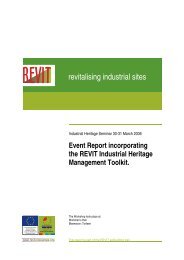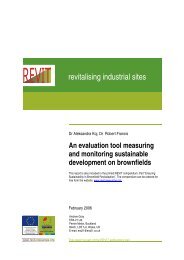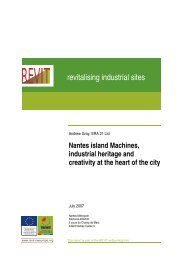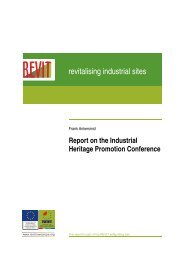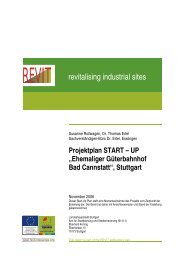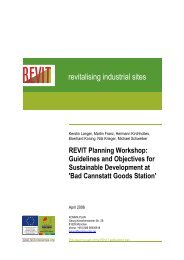REVIT Heritage Report.pdf
REVIT Heritage Report.pdf
REVIT Heritage Report.pdf
You also want an ePaper? Increase the reach of your titles
YUMPU automatically turns print PDFs into web optimized ePapers that Google loves.
Torfaen County Borough Council<br />
<strong>REVIT</strong>: A Review of the Conservation of Industrial <strong>Heritage</strong> Assets on Brownfield Sites<br />
4.6.2 The development is managed by a Project Partnership which includes the<br />
'Rijksdienst voor de Monumentenzorg'(National Trust) and is based around an<br />
independently monitored project covenant. A covenant was agreed between<br />
all the interested parties in order to ensure that all parties comply with the<br />
project proposals.<br />
4.6.3 The project centres on the Stork-Dikkers site in Hengelo which dates from<br />
1867 and was built to repair and manufacture machinery largely for the textile<br />
industry. The site is over 50 hectares in size and one of the largest Brownfield<br />
sites in the Netherlands. The industrial decline of the area is partly due to its<br />
separation from the main city caused by a railway, the Twente kanaal and<br />
various roads. Although the site is still partly occupied, some buildings are<br />
becoming vacant and functions are being found for these buildings before they<br />
become derelict.<br />
Conservation Approach<br />
4.6.4 The site contains a number of historic industrial buildings which are of national<br />
significance and the intention is to integrate these features as a fundamental<br />
part of the re-development by:<br />
• using the cultural component to promote the area;<br />
• integrating the characteristics of the historic area in the overall<br />
reorganization; and<br />
• fixing these qualities in the planning and process.<br />
4.6.5 A master plan was published which set out to transform the area over two<br />
decades from an isolated mono-functional, industrial complex into a multifunctional<br />
part of the city, whilst still retaining the essential qualities of the<br />
existing industrial buildings.<br />
4.6.6 The following rules were used in defining the strategy:<br />
• maintain everything that works;<br />
• transform only if it leads to partial and/or complete improvement; and<br />
• a flexible approach with all options kept open.<br />
4.6.7 One of the first actions of the Project Partnership was to commission an<br />
inventory and analysis of the historic site in order to determine which industrial<br />
buildings should be preserved at all cost and what function should they serve.<br />
The results of the survey were made available to the public as a book with a<br />
short history of the site.<br />
Main Historic Features<br />
4.6.8 The character of the area has been maintained by considering the original<br />
scale of the area and the buildings, retaining the structure of the industrial<br />
roads and railway system and using the historic stratification of the various<br />
production processes to form recognisable sub areas.<br />
4.6.9 Hengelo originally developed as a weaving centre and the development of the<br />
textile industry accelerated in the middle of the nineteenth century with the<br />
arrival of the railway system to Germany in 1865.<br />
4.6.10 When the Stork factory complex was built by the pioneering entrepreneurs the<br />
Stork brothers, in 1867, the initial layout was based on freestanding buildings<br />
0014021/JM/001 36




